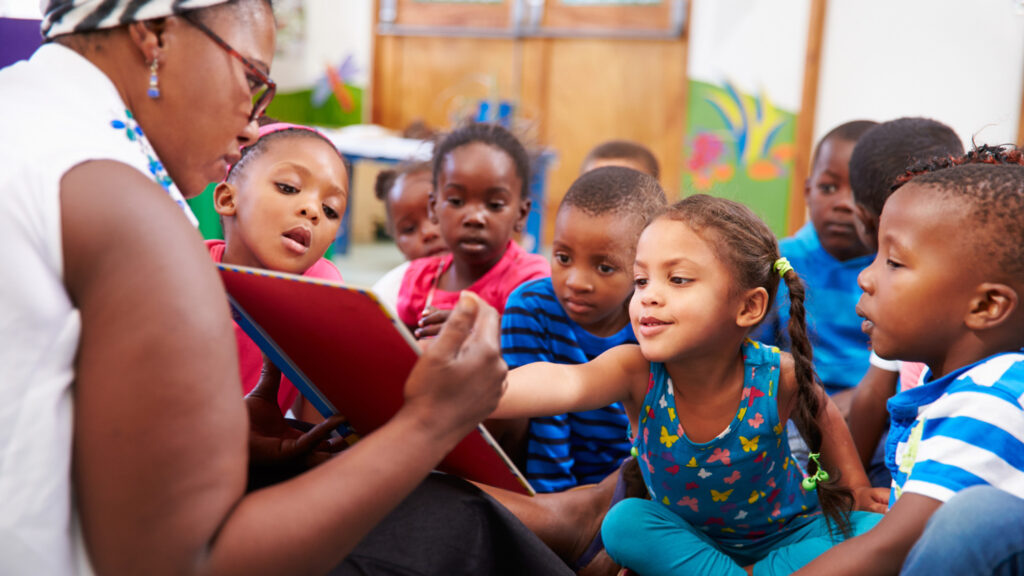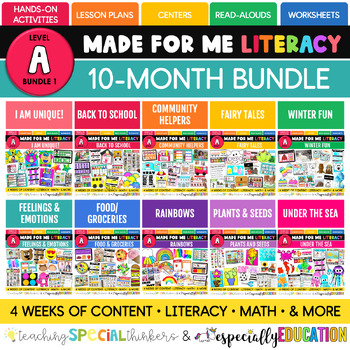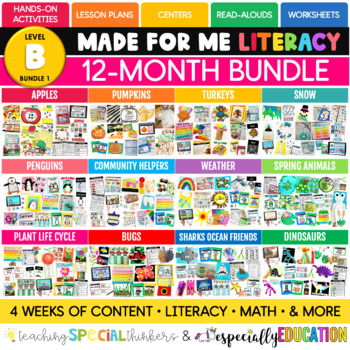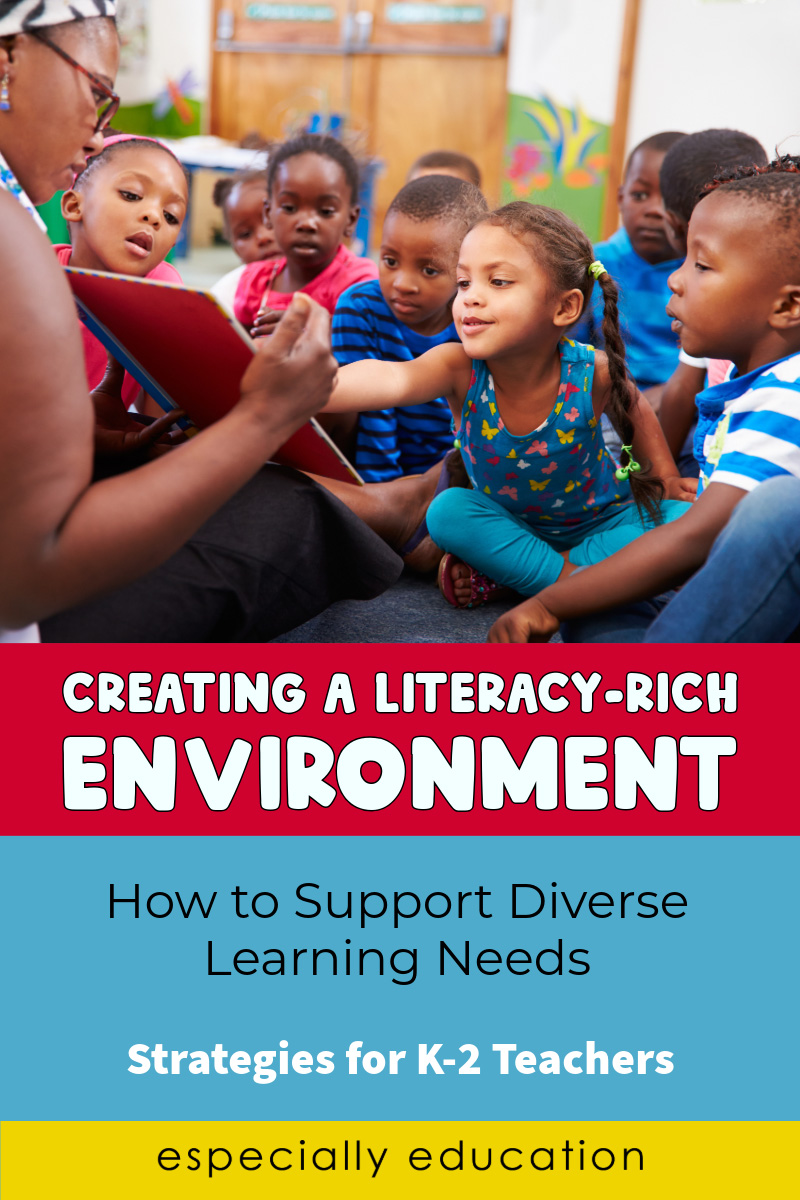Teaching literacy to early learners requires creativity, patience, and a deep understanding of each student’s unique needs.
For kindergarten through 2nd grade, the goal is to make reading and writing accessible, engaging, and effective for all students, regardless of their learning challenges.
Here, we’ll explore practical strategies and activities for adapting literacy instruction to support diverse learning needs, ensuring every child can experience success and joy in their literacy journey.

Understanding Diverse Learning Needs
Students in early education classrooms may have a variety of learning needs, including:
INTELLECTUAL DISABILITIES:
Students may learn at a slower pace and require more repetition and reinforcement.
AUTISM SPECTRUM DISORDERS:
Students may have difficulty with communication and social skills, and may benefit from visual supports and structured routines.
SPEECH AND LANGUAGE IMPAIRMENTS:
Students may struggle with expressive and receptive language, necessitating speech therapy integration and alternative communication methods.
SPECIFIC LEARNING DISABILITIES:
Students may have difficulties in specific areas such as reading (dyslexia) or writing (dysgraphia), requiring targeted interventions.
EMOTIONAL AND BEHAVIORAL DISORDERS:
Students may need behavioral supports and strategies to help them focus and engage in learning activities.
Principles of Adapting Literacy Activities
When adapting literacy activities for diverse learners, consider these key principles:
1. Differentiation:
Tailor instruction to meet the individual needs of each student. This includes modifying the content, process, and product based on students’ readiness levels, interests, and learning profiles.
2. Multisensory Approaches:
Engage multiple senses to reinforce learning. This can include visual, auditory, kinesthetic, and tactile activities.
3. Scaffolding:
Provide temporary supports to help students achieve success. Gradually remove these supports as students become more independent.
4. Repetition and Consistency:
Reinforce skills through repeated practice and consistent routines. This helps students retain and generalize new skills.
5. Positive Reinforcement
Use a token economy system or other positive behavior support strategies to motivate and reward students for their efforts and achievements.
Adapting Reading Activities
1. Interactive Read-Alouds
- Read books aloud to the class, incorporating questions, comments, and actions to engage students.
- ADAPTATIONS: Use picture books with large, clear illustrations. Pause frequently to discuss the story and ask comprehension questions. Use props or puppets to bring the story to life. For non-verbal students, provide picture cards to allow them to participate by pointing or showing emotions.
2. Shared Reading
- Read a book together as a class, with students following along in their own copies.
- ADAPTATIONS: Choose books with repetitive text and predictable patterns. Highlight or underline key vocabulary. Use a pointer or finger to track the text as you read. Incorporate actions or sounds to correspond with certain words or phrases.
3. Guided Reading
- Work with small groups of students at similar reading levels to provide targeted instruction.
- ADAPTATIONS: Select leveled readers that match students’ reading abilities. Use graphic organizers to help students understand story structure. Provide sentence starters or word banks to support oral and written responses.
4. Independent Reading
- Allow students to choose and read books on their own.
- ADAPTATIONS: Create a classroom library with a wide range of books at different reading levels. Use book bins or baskets labeled with pictures and words to help students select books. Provide audio books or reading buddies for students who need additional support.
5. Phonemic Awareness and Phonics Activities
- Teach students the sounds of letters and how they combine to form words.
- ADAPTATIONS: Use multisensory materials such as sandpaper letters, magnetic letters, or letter tiles. Incorporate songs, rhymes, and chants to reinforce phonemic patterns. Provide visual aids, such as letter-sound charts, to support learning.
Adapting Writing Activities
1. Interactive Writing
- Write together as a class, with students contributing ideas and helping to write the text.
- ADAPTATIONS: Use a large chart paper or whiteboard so all students can see the writing. Provide picture cues or word banks to support idea generation. Allow students to use stamps, stickers, or magnetic letters to contribute to the writing.
2. Shared Writing
- Model writing by composing text in front of the class while thinking aloud.
- ADAPTATIONS: Use graphic organizers to plan the writing. Break the writing process into small, manageable steps. Provide sentence starters or frames to support students in contributing to the writing.
3. Independent Writing
- Allow students to write independently, choosing their own topics or responding to prompts.
- ADAPTATIONS: Offer a variety of writing tools, such as adapted pencils, keyboards, or speech-to-text software. Provide visual supports, such as word walls, picture dictionaries, or writing templates. Use a token economy system to motivate and reward students for their writing efforts.
4. Writing Centers
- Set up areas in the classroom with different writing activities for students to explore.
- ADAPTATIONS: Include a variety of materials, such as letter stamps, story starters, or picture prompts. Provide clear, simple instructions with visual supports. Rotate the activities regularly to keep students engaged.
Integrating Technology
1. Assistive Technology
- Use technology to support students’ literacy development.
- ADAPTATIONS: Provide speech-to-text software for students with writing difficulties. Use text-to-speech software to help students with reading comprehension. Incorporate interactive e-books and literacy apps that offer engaging, multisensory experiences.
2. Interactive Whiteboards
- Use interactive whiteboards to enhance whole-group instruction.
- ADAPTATIONS: Display large, interactive texts for read-alouds and shared reading. Use interactive games and activities to reinforce phonemic awareness and phonics skills. Encourage students to come up to the board to participate in writing and reading activities.
Collaboration and Support
1. Collaboration with Specialists
- Work with speech-language pathologists, occupational therapists, and other specialists to support students’ literacy development.
- ADAPTATIONS: Incorporate strategies and tools recommended by specialists into your literacy instruction. Attend team meetings to discuss students’ progress and adjust interventions as needed.
2. Family Involvement
- Engage families in supporting their child’s literacy development at home.
- ADAPTATIONS: Provide simple, clear instructions for literacy activities that families can do at home. Offer workshops or informational sessions to teach families about literacy development and strategies. Send home books, games, and materials for families to use.

Creating a Literacy-Rich Environment
1. Classroom Library
- Create a welcoming space with a variety of books and reading materials.
- ADAPTATIONS: Organize books by level, genre, or theme with clear labels and pictures. Include books in students’ home languages and representing diverse cultures. Provide comfortable seating and quiet areas for reading.
2. Print-Rich Environment
- Surround students with written language in the classroom.
- ADAPTATIONS: Label classroom objects with words and pictures. Display student work, charts, and posters related to literacy. Use word walls to highlight key vocabulary and sight words.
Monitoring Progress and Adjusting Instruction
1. Assessment
- Use a variety of assessment tools to monitor students’ literacy progress.
- ADAPTATIONS: Include formal and informal assessments, such as observations, checklists, and running records. Use assessments to identify students’ strengths and areas of need, and adjust instruction accordingly.
2. Data-Driven Instruction
- Use assessment data to inform and guide your literacy instruction.
- ADAPTATIONS: Group students based on their literacy needs and provide targeted interventions. Track students’ progress over time and adjust instruction as needed to ensure continued growth.
Empowering Every Learner Through Adapted Literacy Instruction
Adapting literacy activities for diverse learning needs in an early education setting requires a thoughtful, flexible approach that respects and responds to each student’s unique abilities and challenges.
By differentiating instruction, using multi-sensory approaches, providing scaffolding, and creating a literacy-rich environment, teachers can help all students develop the skills and confidence they need to become successful readers and writers
Collaboration with specialists and families, along with ongoing assessment and data-driven instruction, ensures that literacy activities are both effective and engaging for every learner.
Using these strategies, kindergarten through 2nd grade teachers can foster a love of literacy and unlock the potential of every student.
Discover the Benefits of Especially Education’s Curriculum
Choosing downloadable, adaptable curriculum materials from Especially Education and Made For Me Literacy means embracing a resource tailored to the unique dynamics of early childhood and special education classrooms.
Our resources are crafted with flexibility and inclusivity at their core, ensuring that every child’s learning needs and styles are met.
Both teachers and parents can rely on our expertly designed activities to bring out the best in every student, promoting engagement, understanding, and joy in learning.
By incorporating our materials into your educational routine, you’re not just teaching; you’re transforming the way education is delivered, making it a more responsive, effective experience for all.
These MFML Bundles of Lesson Plans are Teacher Favorites:
Click on images to check them out on Teachers Pay Teachers



Leave a Reply